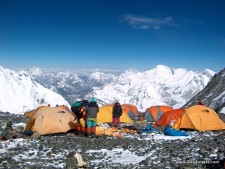
Knowing a fellow climber had died the day before, no it was time to focus on safety and Wednesday nights climbers were forced to make some tough decisions.
The winds were predicted to lessen starting on May 16, but several teams climbed to the South Col on the 15th hoping to get a jump on the crowds. However, ed the winds held fast last night.
Meanwhile several more teams moved to Camp 2 on the South preparing to go for the summit over the next few days. Over 120 climbers are looking at attempting the summit just on May 19th. This is not as bad as it sounds as the South Col route can support 100 climbers if the weather is good. Also, remember they have put dual lines in at the bottleneck on the Hillary Step.
The good news is that this weather window is expected to last through May 25th so teams will have a lot of flexibility.
South Delays at the Col
The Pune team from India with Giripremi Mountaineering Club decided the winds were too strong and are now holding at the South Col with plans to try again tonight, Thursday. They did put climbers on the summit of Lhotse Thursday morning.
Also starting from the South Col but turning back were Brazilian Karina Olani and film maker Scott Simper. They are climbing with Peak Promotions. Melissa Arnot was also denied the summit. She returned all the way to Camp 2 and will try again in a few days.
Sounds like no one made it last night.
The Berg Adventures team also was thwarted by the winds. This update from Steve Whittington directly from the South Col:
Yesterday we reached the South Col a little later than expected due to the high winds. The high winds persisted during the evening and instead of going to the summit, we stayed in our tents. We stayed a full night on Oxygen at 26,000ft. We are hoping tonight as the winds will go down then we will have a chance at 8 o’clock to head to the summit. We talked to our lead climbing Sherpa and we made a decision that if we get to the balcony and the winds are still really high, we will have to turn around. You can’t hear right now but the winds are incredible high here. Anyway, this is what we came for, this is our one shot at the summit and I suppose these next few hours are our final count down to the summit.
They will leave at 8:00PM, Thursday night May 16 if possible. I assume all the other teams are looking at the same schedule
I spent an extra night at the South Col in 2003 and it was miserable. We had four people in one tent, close quarters with down suits and -4oF/C sleeping bags plus packs and boots. It was difficult to sleep even with oxygen, and difficult to digest anything. But the mental pressure was probably the worse with listening to the constant wind and not knowing if you would get your chance.
North Preparations
The news of Alexei Bolotov’s death traveled fast. Phil Crampton, Altitude Junkies, on the north made this post along with an update on their plans to hold another day at ABC to avoid some crowds and take advantage of the lowest winds that are predicted towards the end of this window:
I am deeply saddened to hear the news that a friend of mine, whom I have climbed alongside with in Pakistan several times before, has died on the south side of Everest. I send my condolences to Alexei Bolotov’s family and friends. He was one of the strongest climbers I have ever known and the Himalaya has lost another legend way too early.
This morning the team consulted the latest weather forecast and collectively made a decision on our summit date. Several teams are now moving up from advanced base camp hoping to make the summit from the 17th onwards. We have opted to play it safe and avoid the larger groups’ summit days and go when the wind speeds are predicted to be at their lowest. All going to plan, we should leave advanced base camp on the 18th for the North Col. We will spend the following evenings at camp two (7,800m) and camp three (8,300m) respectively before hopefully reaching the summit on the morning of the 21st.
David Liano going for his north summit after topping out from the South on May 11, will try to summit the morning of May 18th. He will become the first person to summit from both sides in one season if successful.
As we wait for another wave tonight, I thought I would repost a popular description of the summit climb I first wrote last year.
The Death Zone
There is a reason it is called the ‘Death Zone’.
Popularized by Jon Krakauer in the book Into Thin Air, the term Death Zone has come to symbolize the risk of climbing Everest. It was first coined by the Swiss Doctor Edouard Wyss-Dunant who almost reached the summit of Everest during the 1952 Swiss Everest Expedition. He portrayed the effects of altitude on human physiology and defined a number of acclimatization zones in his book The Mountain World.
The highest zone he called the Todeszone (German for Death Zone), defined as starting at 7,500 meter (24,606 feet) At this altitude and above, Wyss-Dunant stated, not only could normal human functions not be maintained, but they rapidly deteriorated – even with the use of supplemental oxygen. The level was later revised to be 8000m or 26,246 feet.
Climbing in the Clouds
So it is with great trepidation that climbers enter the Death Zone. Much attention is paid to the Khumbu Icefall and Lhotse Face, rightfully so, but little is said in detail about those hours above the South Col. So let’s take a very close look at the route above the South Col. If you will allow me, I’ll use my own personal experience of 2011 climbing the South Col route as the basis.
The first few rotations to Camps 1 and 2 and especially Camp 3 feels devastating to most climbers. They struggle to breath, their legs cry out as muscles are deprived of red blood cells. They wonder why they are there and how they can ever go higher; but they do.
For many, there is light at the end of the Everest tunnel the day they start using supplemental oxygen. All of sudden, the energy is back as well as the belief they can do this. However, below 8000m, it is just a placebo.
The real test starts when you hear the wind drop on the South Col, the stars come out and the Sherpas hustling around your tent. You hear your name called out in that now so familiar Nepalese accent – it brings comfort in this strange place. You put your oxygen bottle or two into your pack along with a couple of liters of water, an energy bar, extra pair of gloves, sunglasses and not much more.
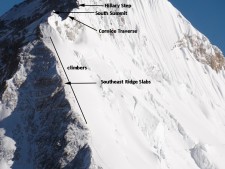
You clip on your 12 point crampons, zip up the down suit, pull on the mask and look up. A stream of headlamps show the way. You start walking.
South Col: 26,300?/8016m
Welcome to the moon. This was home for a few hours as you recovered from your climb from Camp 3. More than likely the wind is blowing so hard you think this is the end of your journey. But usually with sunset, the winds follow the sun.
From the South Col you can see Cho Oyu clearly in Tibet. Lhotse is to the South. You cannot see the true summit of Everest from the South Col but the South Summit of Everest looms to the North.
A vague path in the snow meanders up across a blue ice bulge marking the beginning of the Triangular Face. Leaving the South Col, you go too fast, everybody does. You begin to hyperventilate before you hear your Sherpa call out “Bistarai Bistarai”, slowly, slowly. Following directions you get into a groove.
The climb feels slow, plodding; almost boring. Step by step you gain altitude and get into a rhythm. Every few steps you must unclip your jumar and carabiner from the fixed rope – not both at the same time, and move them above the anchor. This is time consuming, awkward, annoying. You are tempted to skip this but know better.
But you begin to wonder if you are going too slow yet if you go faster you cannot. This is tough. The angle feels steep. It is dark, cold and now that damn wind has picked back up. All you can see are your boots in front of you, illuminated by your headlamp. All you hear is your breathing. How much further?
Balcony: 27,500?/8400m- 4 – 6 hours from South Col
After an eternity, you turn right and see headlamps still, no movement. It must be the Balcony – and rest. You slip off your pack, wanting to sit down heavily on it but it is time to swap out your oxygen bottle – your’s is finished. For almost all western climbers, the Sherpas handle this task – remove the bottle, unscrew the regulator, leave the empty at the Balcony for retrieval on the way down, put the regulator on the new bottle and back into your pack – test it; often the system is frozen with ice. Hot tea or a sharp blow normally fixes it but not always and sometimes ends the climb.
You eat, drink half a liter and begin to feel alive again and then you look up, to the West. It looks vertical even though it is not, but everything is now exaggerated. A mixture of doubt and excitement confuse your already fogged brain. It is time to leave.
South Summit : 28500?/8690m – 3 to 5 hours from Balcony
The climb begins with a gentle angle, this is not so bad, you tell yourself, but then everything changes as the pitch increases – along with your breathing. Higher and higher in the dark, this feels like nothing you have ever experienced. It is dark, cold, probably windy. You are starting to feel incredibly small – a speck on a huge rock. You take comfort from your teammates, the fixed line, the view of your boots, memories, anything to keep you human.
The terrain shifts from snow slope to rock outcroppings. Nobody talks about this, most don’t remember. Each outcropping requires more effort than you have. You clumsily search for a toe hold with your crampon’s front points, a mistake, use your entire foot but the angle is steep, the holds are small; this is hard. Your foot slips stealing precious energy.
It takes a long time for most, every few moments stopping, bending over, ice ax in hand- the 1000 yard stare. But you keep going. You find the 1 reason to keep going, not the 1000 to turn back.
The suns starts to rise as you crest a bump on the Southeast Ridge, you are near the South Summit. The angle relaxes but then picks back up – when will this end? And this is not the summit? The views of Lhotse and the sun rising to the east is indescribable at this point. The chatter on the radio has been silent during this section, climbers lose radio contact with EBC in this section.
The South Summit!, another oxygen bottle change, probably your last. And there it is – the true summit of Everest, softly lit in the morning dawn. Your heart misses a beat several in fact. You just might make it!
Hillary Step – 1 hour or less
After another food and water break, you get yourself together and go downhill. What, downhill? It is a short section of maybe 50 feet but enough to make you question if you are on the correct route. You are, follow the ropes, the climbers ahead. In the mental fog of the early morning, you cross the Cornice Traverse, a section only a few feet wide that drops off a mile on both sides. Amazingly, you stay focused on ahead, up; not down. There it is, the Hillary Step, no it is a false rock formation you need to overcome.
But then the real Step appears. It does not look that hard, you justify to yourself. If you are with a few climbers, it goes fast, if you are with a huge crowd, it is the longest time of your entire life.
Climbing blind you make your moves up the Step. Between your oxygen mask, goggles, down hood, down suit, it is almost impossible to see your toes. Feeling with your feet, holding on with your hands you move higher, each small step is progress to the top of the step. If this home you would scramble up, at 29,000′ you struggle.
Then you finish, but realize the rope goes to the left, around a huge boulder but there is no path? Follow the rope, you tenderly use a death grip high in the death zone as you maneuver around the rock, a bear hug works. And then relief.
Summit: 29,035?/8850m – 1 hour or less from the Hillary Step
You can see the snow slope ease now. Snow cornices mark the right side of the slope juxtaposed against the rising sun to the east. You want to stop and stare, take a picture, a movie, let it sink in; but you are not there. Now you are running on pure adrenaline. The wind burns your left cheek as it picks up, your eyes water; maybe from tears.
And then you are there.
Climb On!
Alan
Memories are Everything

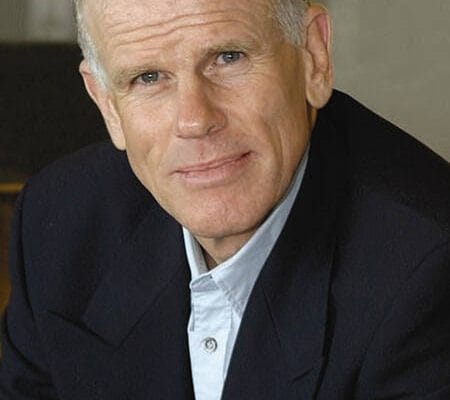
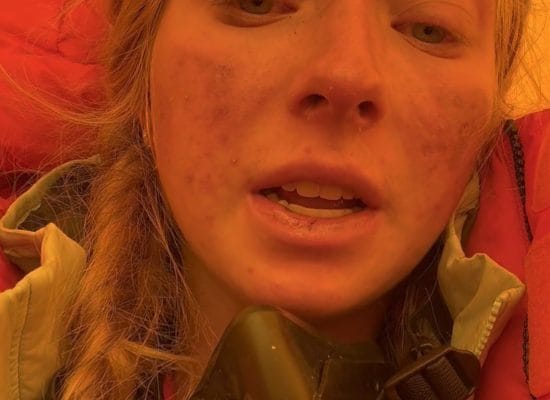
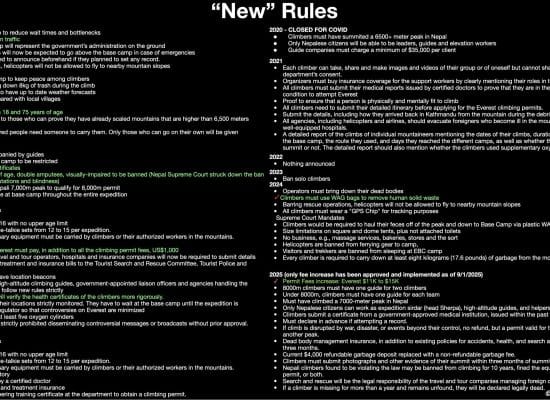
19 thoughts on “Everest 2013: Delayed Summits and More”
Alan – I followed your every move on Everest in 2011, and the first time I read your description of the summit push and summiting, the hairs on the back of my neck stood up. When I read it again today – same reaction. Thanks so much for telling us who are earth-bound what the journey is like. As Dragos said above – “I will the book. Just write it Alan.”
Thank u for sharing this information Alan, it’s fascinating… MAE
Thanks alan for thenpost.
Such a detailed report of you experience… Wow man, you were lucky to be there.
Great blog Alan. for a moment I felt like I was physically there!
Hi Bandar
I followed your climb last year which ended up being rather scary. For some reason you reached the summit with Mingma who took loads of photos but you were done in. O the way down there was a panic because either your oxygen ran out or there was a block on your bottle. I remember you told people to move as there was an emergency. Another Sherpa came up with another cylinder and you got down ok. You said it had been the worst thing you had done in your life but also the best. Hope you are fit and well and following in comfort this year. Kate Smith (UK)
Hello Kate,
Great Memory. Mingma summited twice that day, I had only joined with him on the South Summit when Kanchha, who I was originally with, went down.
It does seem mingma likes the camera, while I was posing and getting out my flags on the summit, I found he had taken a ton of photos with my camera! Mingma is a very strong climber.
Yeah I had my issues with the oxygen last year, but it only makes it that much more memorable. My first bottle had a faulty regulator, then my mask broke, then my second bottle had a faulty regulator which is why I ran out. I had spent about 3 hours in total with no oxygen that day, 2 before the summit and 1 after. I had used one of the emergency bottle up there but had to go down the hillary step without O’s to get it. In the few months afterwards it was a bit difficult as I had completed my seven summits and found myself with, something I later found out is very common, a post everest slump.
Now all is well and the whole team is healthy and happy. Regarding Everest, definitely the best thing done. Looking forward to heading back to the mountains next year, but Im a father now so I won’t be going to any 8000 meter peaks.
Bandar
Great to hear from you Bandar. Congratulations on becoming a dad . I have four children and nine grandchildren absolutely great. I hope wherever you climb next year that you post a blog as I so enjoyed following you. I am sitting here in my armchair wearing my Everest Hoodie printed by Ellis J Stewart who is hoping to climb Everest next year but it is so hard to get help with funding.
Meanwhile thanks for message and enjoy your family Cheers Kate
Even though I have read this blog twice already, can’t help but read it again.When Im waiting for news it keeps me on the spot. If I don’t like the waiting can’t imagine how the climbers feel. When you go next year Alan which side are you going and why Cheers Kate
So exciting makes me feel I am there! 🙂
So exciting! Loved reading your blog Alan, thank you.
Thanks Jim.
Patience & strength to all the climbers up high on Everest right now. A great blog Alan Arnette!
This is such a stunning site Alan – well done. I visit it every year! Thank you
Hey Alan,
Thanks for the continued great coverage.
You say over 120 climbers looking to summit on the 19th, does that include the sherpas? Do you have any data of how that compares to May 19th last year?
Also, regarding the dual lines wish that was there last year. Such a simple idea that might have saved so many of us much anguish.
Looking forward to seeing the summit reports.
Bandar
Superb description of the Summit climb! Wow! Thank you Alan! And wishing all those getting ready for the summit the best of luck and safe return. Hope the wind drops sooner rather than later 🙂
I will the book. Just write it Alan. 🙂
Regarding Mallory and Irvine summiting Everest back in 1924.
After reading countless accounts on the subject I personally believe that only Mallory summited Everest in 1924, not Irvine (he probably waited at the first or second step for Mallory to return). Therefore it is difficult for me to give an answer to your question: “Do you believe Mallory&Irvine summited Everest in 1924?”. I suppose others share my embarrassment.
But as usual I’ll follow your advise: Climb on!
Best,
Benoit
Thanks Alan great description.
Thanks for that Alan! Your descriptions amaze and astound me, thank you. Let’s hope everyone has a safe climb up and down.
Comments are closed.